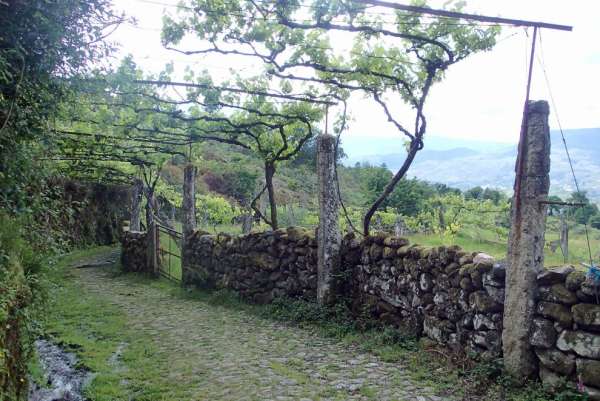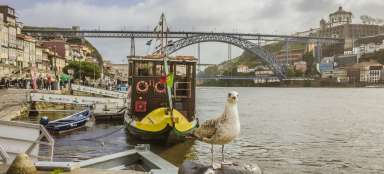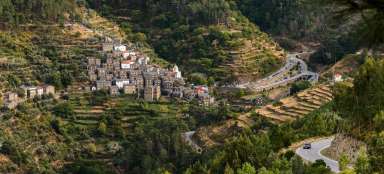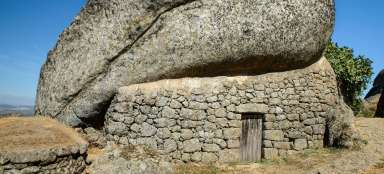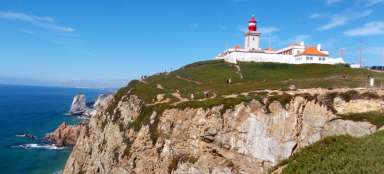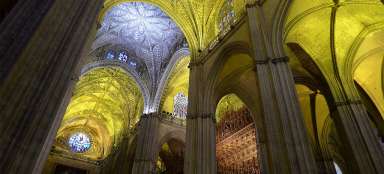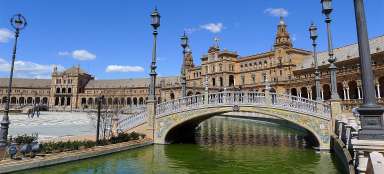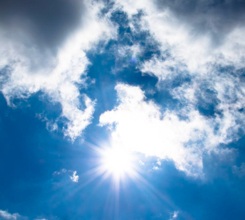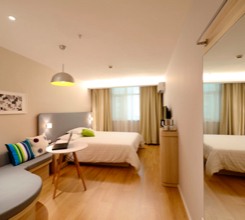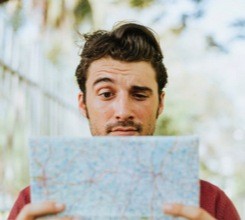Less known northern part - coast, towns and mountains
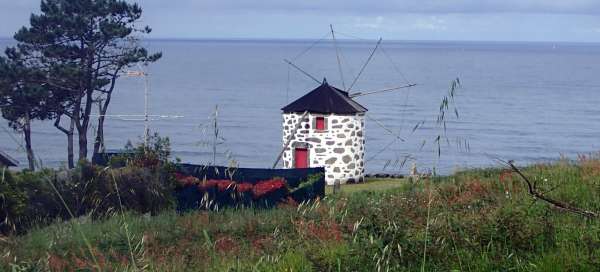
We wanted to enjoy peace, quiet and all this at prices similar to ours, so we decided to go to Portugal and, among other things, explore its lesser-known conservative northern part.
Direct flights to Porto are available at reasonable prices, so offers to start traveling there. Porto is the second largest city in Portugal and is rightfully inscribed on the UNESCO list. A walk through the old center of this amazing city with its winding streets is definitely worth it, as well as the view of the city from the cathedral and the famous steel bridge. Most of all, however, we liked to wander along the waterfront, which has a really distinctive look and atmosphere. We lived on the outskirts of the city, so we had to use the metro a lot, but rather a heavier tram. However, it is not complicated or expensive, although it is quite crowded due to the relatively long intervals. The experience, however, is a ride over the impressive high steel bridge Ponte Dom Luis, which dominates the valley. The bridge has two floors, at the top the metro slowly passes by crowds of tourists, at the bottom cars and buses run again around the sidewalks full of people. The prices on the waterfront are quite touristy, but the atmosphere is worth it – a variety of colorful houses around the waterfront of the wide Douro River and above it a huge old steel bridge. After all, you don't have to sit in a restaurant, the atmosphere and performances of street artists can be enjoyed while walking or sitting on a bench. We could not miss a boat ride, which cost us EUR 16 per person, including a tour of the local Port wine factory and a tasting of the two products. The ride was pleasant, looking from the boat to the houses on the waterfront and crossing a total of six high bridges was definitely worth it. The tour of the production museum was too long, but the fatigue from the detailed explanation was reliably removed by tasting excellent products. In the evening we walked through the city streets with houses lined with „azulejos“ tiles and sat in a local restaurant, where in addition to wine and traditional „Tapas“ we also tasted the local vegetable soup „Caldo verde“. Vegetarians beware, there is sausage in Portuguese vegetable soup. The Portuguese do not really spare meat at all in the menu, especially fried. The next morning we packed ourselves in the subway and for 2 EUR we arrived at the airport, where we had ordered a car rental. We booked the car in advance on the Internet and thus reached for renting a four-door car with air conditioning for six days with full insurance of all risks for a very nice price of 86 EUR (half the price is insurance, if someone risks it, then with basic insurance it would be only an incredible 43 EUR). For this price, they rented us an almost new Nissan Micra. The car is handy, quite spacious and yet light. It is equipped with a 0.9 turbo engine, so it drives pleasantly and quietly, but sometimes the driver has the impression that he is driving a larger car on the Matějská pouti. A pleasant reward, however, is our low consumption, which is pleasant given our higher price of gasoline than ours. We were a little worried about driving in the „wild south“, but as it turned out to be unnecessary. Only two-lane roundabouts required increased attention due to the predatory approach of some local drivers. Roads and highways are generally in a much better condition than in our country, which is probably due to the mild winter. Tolls are paid on motorways according to the kilometers traveled (somewhere electronically somewhere tickets), which we solved in agreement with the car rental company by renting an electronic box, which ensured comfortable passages through the gates without stopping. So we head north, just above the town of Viana do Castelo, where we rented a small bungalow not far from the sea. Along the way we will see the city port, the Basilica of St. Lucie and we will enjoy the streets, houses and squares of this pleasant city. The Praca da República square with its fascinating 16th-century fountain and magnificent Renaissance palace deserved the most attention. A 562 meter long steel bridge built by the Eiffel leads across the Lima River. While walking along the sea, we admire the toughness of surfers, who can stand for hours in very cold water in neoprene. On the way out of the city, we check the Intermarché supermarket, where we pay special attention to the fish department and the extensive selection of good wines, starting at 2 EUR. The typical dried „Bacalhau“ cod makes itself feel all over the store, but the fact that it offers piles there proves its popularity. The Portuguese are said to know 365 recipes for its preparation. We enjoy walks around the sea with views of the rocks reaching into the sea and we even saw a functional windmill. In many places before the season, they expand the network of comfortable paths for pedestrians and cyclists, but we prefer areas with more romantic stony paths in the middle of rocks with extensive stands of all sorts of „rock“ pillow stands – heather, rodents, carnations and ubiquitous cilimniks. It is possible to find nice beaches among the rocks for swimming, but very few people decide to go into the water, even in summer the water reaches up to 18 degrees. The next day, due to the rainy weather, we planned a car trip along the coast to enjoy the countryside and local villages with churches and very nicely landscaped cemeteries, often with lavish tombs. On the way we will stop at Vila Praia de Ancora, a typical modernized holiday town, with a beach, a port and the usual coastal fortress, reminiscent of the difficult times of the struggle for Portugal's independence. At this pre-season, however, it is only a sleepy residence, which is used mainly by surfers. Next on the route is Caminha, a pleasant town on the border with Spain at the confluence of the rivers Rio Couro and Rio MInho, which offers a walk through the medieval streets with „tiled“ houses and sitting in the old square with a fountain. While sitting in a cafe with a traditionally excellent coffee, we enjoyed the peace disturbed only by occasional cycling groups and passing pilgrims on their way to Santiago de Compostela. At the northernmost point of our journey lies the tens of thousands of very well-maintained town of Vila Nova de Cerveiro, founded in the 14th century, dominated by a large well-preserved castle above the Minho River. In addition to the church, we were also interested in the house „Casa Verde“ on the square, where green is used for tiles on the house instead of the usual blue. We turn south and stop along the way in one of the oldest Portuguese cities – Ponte de Lima. We are captivated by charming ancient houses, churches, alleys and squares along with the remains of the city fortifications. The most important, however, deserves the ancient bridge over the river Lima, whose history dates back to the Roman Empire. We will end the walk around the city and the seafront promenade by sitting in a café by the bridge, where we enjoy the atmosphere by watching pilgrims who, after crossing the bridge, line up in front of the „Albergue dos Peregrinos“ hostel. We already have enough coasts and small towns, so the next day we go inland. Look at the local hills to the Serra de Arga area. The destination is the village of Montaria, where first we do not forget to taste great coffee in the bistro as always. The village is beautifully landscaped and in addition to the church and Calvary has a clear map of routes in the area. Finally, due to the fact that it is foggy and cloudy, we choose a shorter valley path marked PR 5 – „Trilho do Pincho“ instead of scenic routes in the hills. All roads are well marked with tourist signs, but the marking system is a little different than in our country, the routes are numbered, not distinguished by colors. In addition to the usual route markings, they also place a cross mark on the branches to mark roads that lead outside the route, which in our experience is quite a useful convenience. However, the map and GPS are still useful for sure. We start our journey on the square, where we will not forget to see the reconstructed church of St. Lorence, then on the edge of the village we pass, as always, a beautifully landscaped cemetery and enter the area of vineyards. We were interested in the fact that in addition to the classic management, there is a very popular management of the vine overhead. The road continues between the fields and is lined with water channels, reminiscent that the nearby mountains are very watery. Due to the mountainous surroundings and recent rains, the mostly rocky maintained roads are flooded with water in some places, so sometimes we have to choose sandy paths leading to unused meadows overgrown with ferns. The temperature rises gradually, so the surrounding forests smelled of pine trees and especially distinctive eucalyptus trees. On the way through the forest we come to a local attraction – the waterfalls „Cascata do Pincho“, which can be described with a bit of exaggeration as the local tiny Plitvice. After crossing the road, we find ourselves on a path leading around the rocks along a long small water canal, branching off from the river Rio Anchora, so the imagination gives us the impression that we have moved from Croatia to the Madeira levada. We wake up in the morning and it is raining, the sky is completely cloudy, the temperature is 16 degrees, so we envy those who stayed at home in the Czech Republic, where it is a good 10 degrees warmer and clearer. With regard to the weather, we again choose the city program. We go east to the historic city of Braga. On the „Praca de República“ in the rain, we appreciate the arcades and admire the local tiled houses, and we will not forget to visit one of the local old-fashioned cafes. On the way through the pedestrian zone we get to the oldest cathedral in Portugal, because it began to be built in 1070. The great importance of this city for Christianity is also expressed by the fact that the local archbishop is the primate of Portugal. A few kilometers outside the city is the main destination today – the pilgrimage site of Bom Jesus do Monte. The huge car park suggests that it is really busy on big holidays. Fortunately, now there are only a few tourists and probably only two tourist buses. We start the way up with the winding Way of the Cross „Via Sacra“, but the chapels that line it are unfortunately quite dilapidated. Finally, the famous monumental Baroque staircase appeared. Climbing up more than a thousand steps is not so strenuous. We diversify it by admiring the statues depicting the four human senses, followed by three virtues, where faith, hope and love of neighbor are allegorically depicted. A tour of the basilica, which is the second most important shrine in Portugal after Fatima, will complete our mini-pilgrimage today. With regard to the rain, a walk through the adjacent large park with a pond does not attract us so much and we will despise the offered boat ride. On the other hand, the technical part of our expedition is fascinated by watching and exploring the local technical rarity – the „Elevador do Bom Jesus do Monte“ water-powered cable car. The principle is simple, after all it has already been described by Jára Cimrman, only water is used here instead of miners, which is more than enough in the spring on the hill. The cable car goes up, unloads the passengers, the operator connects the pipes and the water begins to flow into huge tanks under the floor of the cable car. In addition, an even smaller water supply fills the brake cooling tanks. And then down the water is drained back into the canal. After the operators of both cabins have agreed to readiness with the help of an ordinary electric bell, the brakes are only released and the upper cable car is pulled upwards by the weight of the water filled. The cable car can hold 30 seated passengers and another 8 can be crammed into an open platform at the end of the car. The whole thing is controlled by the driver sitting on an open platform using two water taps and one brake lever. Communication between the two cars is by means of an ordinary electric bell on the station pole. Just a technical experience! It is unbelievable that something like this still escapes the attention of vigilant EU inspectors. A similar cable car also ran to Prague's Petřín, but only until about 1920. On the last day of our stay in the north, we set out on a longer journey, going east to the Spanish border. We want to visit the Peneda – Gerés National Park. There are a large number of diverse hiking trails of varying difficulty. Everything is very well organized and marked. At the main entrances to the park, in the villages of Lamas de Mouro, Mazio, Lindoso, Campo do Gerés and Montalegre, there are new information centers. ‚Celeiro de grãos‘. They were built sometime in the 19th century on legs about a meter high to protect supplies from rats and other hungry pests. In addition, the granite slabs kept the grain cool and dry. Thanks to the crosses on the roofs, these houses look more like a cemetery at first glance. These granaries can be seen individually in the gardens of some houses and elsewhere in the area and are very abundant in Galicia, but only here have we seen them together. Opposite the church there is a well-equipped new information center, where they gave us good and willing advice and equipped us with a map. Local treks are called „trilho“ here and are named and well marked. Finally, after consulting with a very helpful employee of the information center, due to the advanced time and uncertain weather, we decide on the route from the village of Lourida to the village of Ermida and on the other side of the slope back. The sunken village of Lourida does not make a neglected impression at all, although of course it lacks enough in the grandeur and orderliness of the villages on the main routes. But in the local bistro they offered us a very good coffee again for only 0.50 EUR. We liked the selected route. The path leads along the slopes of the valley of the mountain river Rio Froufe with small waterfalls, where we meet a group of enthusiasts who enjoy canyoning. If necessary, the path can be shortened by walking on a paved low-traffic road. Everywhere there are nice views of the surrounding rocky hills and the river. We were surprised that, despite the low altitude, there are quite a few trees everywhere, which was partially replaced by groves of tall yellow cilimniks. Traces of fires are visible in trees and shrubs in many places. We realize that the Portuguese are especially fond of the abundant burning of branches and remnants of wood during logging in the forest and do not break their heads with any special security. It is therefore no great surprise that, a year ago, Portugal witnessed major fires that killed more than 60 people. Along the way, we pass completely free-grazing cows and reach the valley above the village of Ermida, where there are benches and a statue of the Virgin Mary looking out into the valley. We go down to the village and find a well-marked path back to the valley. Again, we see a local specialty everywhere – running a vineyard high above our heads. The comfortable path is initially lined again with water channels. There really is no shortage of water, which is soon confirmed by the fact that the road is flooded with water. In the end, all that remains is a steep rocky descent to the village, and behind the bridge we are greeted by a local old goat herder and amplified in us by the pleasant feeling of that quiet deserted place. On the last day, on the way back to Porto, we will walk a few sections of the coastal road, where comfortable paths for pedestrians and cyclists are intensively built, we will go to see a few beaches and sea views and we will return to the airport by car. Our fears of a lengthy car return procedure are suddenly gone. The technician just said „you have the insurance at full risk, I don't need to take anything over“. While waiting for the plane, we recapitulate our experiences from Portugal. Yes, it met our expectations, it is not an exotic, but it is an old, good, peaceful Europe. In addition, the northern area is only slightly affected by mass tourism. But the surprise for us was that Portuguese is really different from Spanish and that the weather is much colder than in our country. If we go to Portugal sometime in the future, we would like to enjoy a few moments in Porto again and then set out to look upstream on the Douro River in the famous wine region. And then go somewhere deep into the Alentejo region (Czech „region behind the river Tagus“), look into poorer areas still little affected by tourism and full of olive groves and cork oaks.
Jury - bridge
The biggest landmark of the city is the Ponte Dom Luis bridge
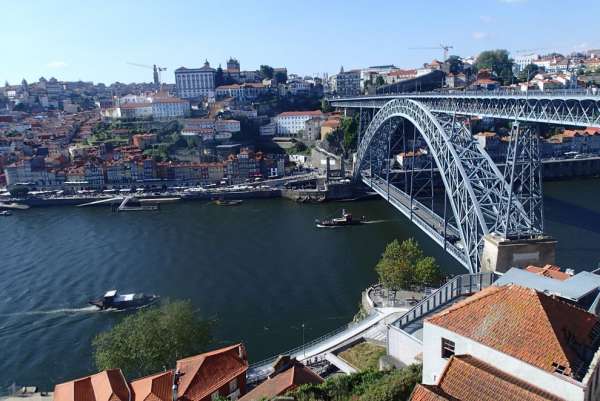
Porto - waterfront
The banks of the Douro River are always full of tourists and boats
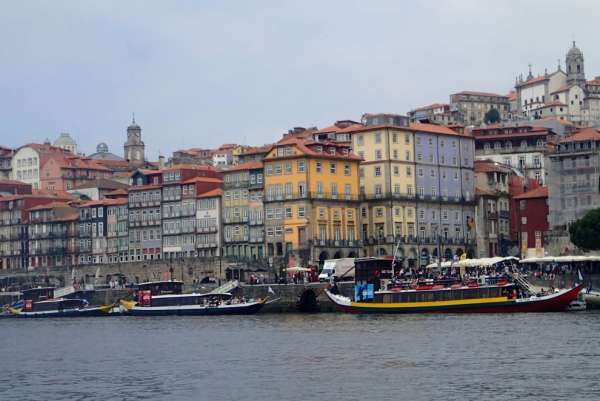
Flora on the sea shore
despite the challenging climate, the trails are variegated flora

Trails on the coast
many opportunities for hikes along the sea

Trails along the coast
the trails are well marked and maintained
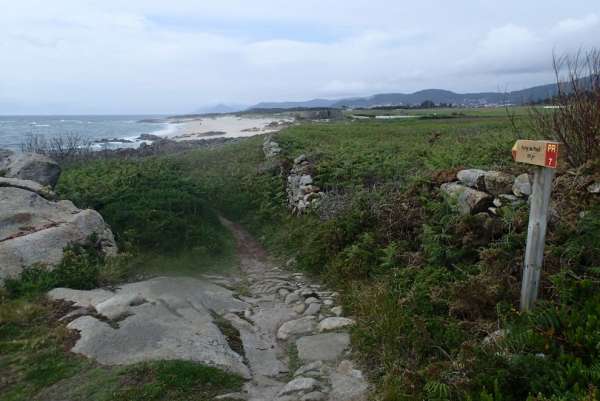
Vila Nova de Cerveiro
fortification of the preserved castle
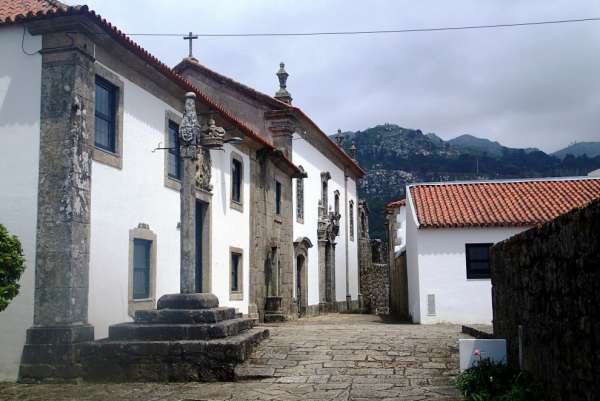
Ponte de Lima
an ancient bridge over the river Lima, whose history dates back to the Roman Empire

Lindoso
typical local granaries, which we initially considered a cemetery. As the most important buildings, they were located just below the castle
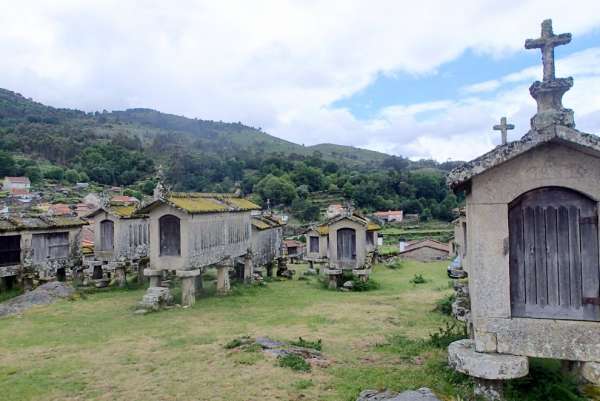
Peneda - Gerés National Park
Road from the village of Ermida back to the valley. The vineyards run high above their heads and the path is lined with water channels.
